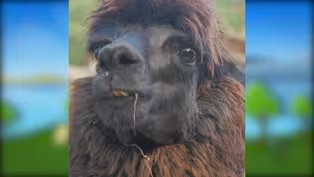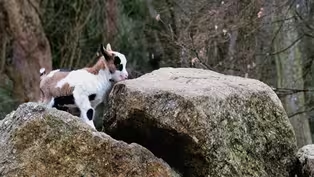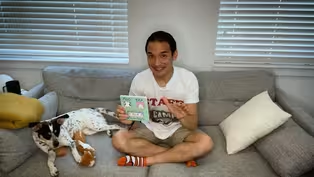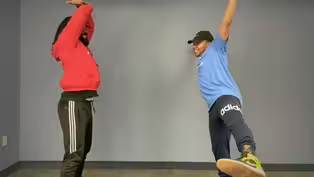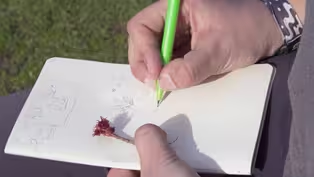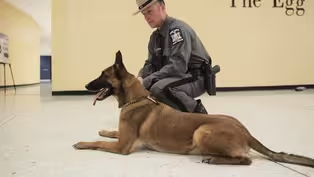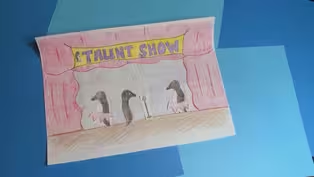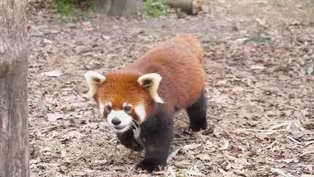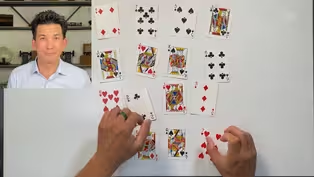
Favorite Animal Day (Long Version)
7/6/2021 | 56m 56sVideo has Closed Captions
Have an animal dance party, make a hungry bunny, meet otters, llamas, and red pandas!
Join head counselor Zach and have an animal dance party! Make a hungry bunny & and a nature journal; meet otters, llamas, and red pandas. Content partners include: Children’s Museum of the Arts, Koo Koo Kanga Roo, Impossible Science, Monterey Bay Aquarium, National Dance Institute, NYS Office of General Services, Seneca Park Zoo, Memphis Zoo, Playworks.
Problems playing video? | Closed Captioning Feedback
Problems playing video? | Closed Captioning Feedback
Camp TV is a local public television program presented by THIRTEEN PBS

Favorite Animal Day (Long Version)
7/6/2021 | 56m 56sVideo has Closed Captions
Join head counselor Zach and have an animal dance party! Make a hungry bunny & and a nature journal; meet otters, llamas, and red pandas. Content partners include: Children’s Museum of the Arts, Koo Koo Kanga Roo, Impossible Science, Monterey Bay Aquarium, National Dance Institute, NYS Office of General Services, Seneca Park Zoo, Memphis Zoo, Playworks.
Problems playing video? | Closed Captioning Feedback
How to Watch Camp TV
Camp TV is available to stream on pbs.org and the free PBS App, available on iPhone, Apple TV, Android TV, Android smartphones, Amazon Fire TV, Amazon Fire Tablet, Roku, Samsung Smart TV, and Vizio.
Providing Support for PBS.org
Learn Moreabout PBS online sponsorship- Hi everybody.
My name is Zach and welcome to Camp TV.
Are you ready for some summer fun?
Me too.
Now as your Head Counselor, I will be introducing you to all sorts of cool activities, arts, crafts, games, math and science as well as some of my favorite books, nature and theater.
I will be here to take you from one activity to the next.
So follow me on Camp TV.
[bright ambient music] - [Announcer] This program was made possible in part by the Corporation for Public Broadcasting, a private corporation funded by the American people.
Additional funding was provided by the Peter G. Peterson and Joan Ganz Cooney Fund and the Pine Tree Foundation of New York.
- ♪ Camp TV is time for us to start ♪ ♪ From furry animal encounters ♪ ♪ Some reading and the arts ♪ ♪ No matter what the weather ♪ ♪ We'll explore it all together ♪ ♪ It's a place for you and me ♪ ♪ It's Camp TV ♪ [whistles] [lion roaring] What was that?
[lion roaring] Okay.
I guess I wasn't that thirsty anyway.
Maybe I'll just grab a snack instead.
[cow mows] [elephant rumbling] Okay, Stout, Trixie, which one of you left an elephant in the refrigerator again?
And do not even try to deny it this time okay?
I saw its footprints in the butter.
Oh boy, it is about to get crowded in here.
So I will quickly say welcome to Favorite Animal Day on Camp TV.
You better head off to your first activity.
In fact, can I come with you?
Okay, thanks let's go.
A little birdie told me it's time to go wide.
- Hi there friends, welcome to the Memphis Zoo.
My name is Bella and I am an animal interpreter here at the zoo.
That means that I get to share the stories of animals and their homes with people just like you.
Today, I'd like to share the story of our connection with wildlife and how we can use that connection to help animals.
We'll learn about animals from near and far including red pandas.
While you might not live near red pandas there are things that you can do to make a difference in their lives.
We're gonna learn about how to do that using a 3Rs, reduce, reuse and recycle.
Let's get started.
Meet our resident red pandas, Mars and Lucy.
While we learn a little bit more about them they're gonna be exploring their habitat and eating some yummy treats.
For the most part when talking about endangered species like red pandas we think of animals that live far away from us.
And while you might not see a red panda in your neighborhood and if you do, it might be a little lost, there are still things that we can do to help them from home.
No matter where you are, they're animals all around you from mosquitoes to finches, to deer all animals are important to their home.
What are some animals that you see outside?
Here in Tennessee, we often see opossums, stinkbugs and red tail hawks.
These animals are common, but that doesn't mean that they don't need our help to make sure that they never end up endangered which is what happens when the number of animals of a certain kind get very low.
Though red pandas might live far away the things that we do at home can help or hurt them.
Red pandas like Mars and Lucy are found in the Himalayan Mountains from Nepal to China.
Despite sometimes being called red panda bears, they are not a part of the bear family.
When people hear the word panda they often think of giant pandas like the pair we have here at the zoo named Lola and Yaya.
While both kinds of pandas are avid bamboo eaters, red pandas are a unique animal that is not closely related to any other.
Their closest relatives are the skunks and weasels.
I think they're a little less stinky though.
Red pandas live in the temperate forests where they spend their days in the trees in search of bamboo and other food to eat.
Lucy loves to eat while Mars spends a lot of his time following Lucy around or climbing high up into the trees.
When he's not by Lucy side, Mars does love to eat grapes and apples along with his bamboo.
Giant pandas eat a lot of bamboo too.
Because bamboo isn't very nutritious, red pandas and giant pandas have some special characteristics called adaptations to help them get to the good part.
First, they use their super flexible wrists and some like toes to hold the bamboo while they strip off the tasty leaves.
Mars and Lucy and Lola and Yaya are very picky eaters.
They only like certain species of bamboo and certain parts of the bamboo.
Here at the zoo, they get over 40 pounds of fresh bamboo to choose from every day.
Because of their eating habits, red pandas need our help in the wild.
In just 50 years, the number of red pandas has been cut almost in half.
Their homes in the mountains are getting smaller and smaller.
Not all is lost though, because there is a way for all of us to help red pandas no matter where we are.
Earlier, I mentioned the three R's.
The three R's are reduce, reuse, and recycle.
Say it with me, reduce, reuse, and recycle.
But what do they mean and how do they help us help wildlife?
Well, allow me to show you.
Let's start with the first R, reduce.
Reducing means to use less of something.
Since paper is what causes trees to be cut down.
We can reduce the amount of paper we use by coloring on both sides of the paper.
Moving on, let's look at the second R, reuse.
Reusing means that we use something more than once.
A lot of things in our lives are used once including straws, forks, and spoons.
Most things can be reused though.
From water bottles to spoons, reusable items can be used for many, many years.
The last R stands for recycle.
Whether or not you have a recycling bin or program in your hometown, you can recycle things all on your own.
Look at this super cute craft my friends and I made, not only is it an awesome toy but it's made of things that people usually throw away like toilet paper tubes, and bottle caps.
When you recycle these items into crafts, they don't end up in the environment.
By remembering the three R's, reduce, reuse, and recycle we can stop trees from being cut down all over the world and prevent trash from being in animals homes.
Thank you so much for joining me today and meeting my friends, Mars and Lucy.
Today, we learned about animals near and far, including red pandas.
We also learned about the ways that we can help animals.
Can you remember the three R's?
Reduce, reuse, and recycle.
By doing that, not only are we saving the planet, but we're also getting some fun crafts too.
I hope you had a great time today.
And from all of us here at the Memphis Zoo including Mars and Lucy, we'll see you next time, bye.
- [Zach] Arts and crafts?
Yes, please, Let's Get Artsy.
- My name is Mackie and I work at the Children's Museum of the Arts in New York City.
I'm so excited to share this week's project with you.
Can you guess what it's going to be?
Here's a hint.
The subject of our artwork today has wings but it can also swim and it's usually found where it's cold.
Do you know what it could be?
Let's find out.
When I'm making art at home I like to use art I have on the walls, books or even things online as inspiration.
So if you guessed penguins in our opening riddle you would be right.
Today we're looking at a piece called Penguin Holiday by an artist named Jim Sailor.
So when I to look at artwork, first I wanna take in the whole thing and spend some time just looking and seeing what I noticed.
So take a look at this artwork.
What do you see?
I see a couple of things.
First, I see a lot of penguins riding on a bus which is sort of funny to me, that's not something you see every day.
So that's interesting.
I also see a lot of different colors but they're sort of all in the same color palette.
I see blue, I see different colors of gray and white, black on our penguins and I also see some green and even some tan that makes me think the bus is driving through the country, maybe they're on a road trip.
Now after you take a look at the big picture now you can look closely, find little details.
What do you notice when you look closely at this artwork?
Can you find where all the penguins are hiding?
So after looking a bit closer, I noticed some other things.
First I found so many places where penguins are hiding..
I see some sitting in seats like they maybe would on a regular penguin bus, but then I see others all over.
They're popping out from underneath, even underneath the bus and the front of the bus, and I also see some penguins even standing outside of the frame.
This artwork is in a frame hanging on my wall, but the artwork itself, the print itself also has a penguin on the outside, almost like looking into the picture.
What else do you notice?
I also notice that each of these penguins looks the exact same.
This is one of my other favorites.
It's called Penguins in Space.
Can you see why?
These penguins are floating around in space with different planets and stars but they look the same as those penguins, and there's still one standing outside of the frame.
So why would this artist choose to make artwork about penguins?
And why would they keep this one penguin the same but change all the settings to be something different?
If you could make an artwork like this where would you take our penguin friends?
Let's make a project inspired by Penguin Holiday and Penguins in Space.
So I've been thinking, cold weather penguins are usually stuck where it's icy and snowy.
And I can feeling a little stuck at home myself and I haven't been able to get to do all the activities that I usually like to do.
So today I wanted to do a project that includes some play and our imagination because using our creativity and imagination, we can go anywhere we wanna go.
All you'll need for our project is some blank paper, scissors, a pencil and something to color with, like colored pencils.
First select the animal or character that you wanna use as the main figures in our artwork.
I wanted to stick with the penguin theme.
So I made a penguin modeled after the ones in Penguin Holiday.
I just drew this on a piece of paper using colored pencils and cut it out so I can move it around anywhere I wanted on my artwork.
You can choose a penguin.
You can choose any animal or any character you want or even a toy or an item around your house.
You decide.
So now we need to decide what are our figures and characters are going to be doing in this artwork.
So take a moment and close your eyes.
Imagine your favorite activity.
Are you going swimming, playing a sport, playing an instrument or spending time with people you love.
Imagine every part of that activity, what does it smell like there?
What are things that you feel or foods that you can taste?
Imagine every little part of that activity or that place and now imagine a penguin there instead or even your character.
We're gonna use these places as the backgrounds for our figures and characters.
So all you need is your pencil and drawing utensils like I'm using colored pencils, you can use markers, paint, whatever you like to use for coloring and then just some plain paper.
And I chose white paper and draw this activity.
Draw the place that you love to go and then we'll add our characters and figures to that.
So this is my blank page but I do have one that I already finished.
I drew a talent show because I love singing and I love performing on stage.
And that's what I miss doing right now when I'm stuck at home.
So I drew this talent show and I'm imagining that our characters are gonna go right on this stage.
Now I can take my penguin or character and place them into my settings.
I can also create props or costume pieces for my penguin and I can make other penguins and add them to my scene too.
I can also save the penguins I created and use them in front of pictures from books, magazines, or other artwork.
They can go anywhere.
When I've completed an art project I love sharing it with family and friends.
Ask family members or friends to act out a scene using the characters you created or have them create characters of their own.
- [Zach] A little birdie told me it's time to go wild.
- My name is Lewis David and I'm an Educator at the Monterey Bay Aquarium.
Today we're gonna be talking about sea otter.
[bright ambient music] Now where's the sea otter's home?
The sea otters home or habitat is called the kelp forest.
Now let's pretend to be the kelp forest.
You can put your arms up in the air and sway them back and forth like the kelp.
[bright ambient music] We have a lot in common sea otters too.
If you have someone near you, share with them or maybe just think to yourself what do we have in common with sea otters?
[bright ambient music] Let's think about what you did this morning.
Were you sleeping?
Maybe you were eating breakfast or brush your teeth or comb your hair.
Or maybe you took some time to play around this morning.
Sea otters do all of those things too.
Think about where you did all of these things.
Did you play around in your home, or brush your teeth in the bathroom, or you take a nap in the bedroom?
Where would this sea otters do all of these behaviors?
That's right, if you said the kelp forests, you're correct.
The kelp forest is very important to sea otters.
The kelp forest is a sea otters bedroom, babysitter and kitchen, all at the same time.
The kelp can be a bedroom as sea otters wrap themselves in kelp so that they don't float away with the currents or get tossed around by the waves.
The kelp is a babysitter 'cause sometimes mommy otters will wrap their baby otters or as we call them pups in kelp, while they look for food.
The kelp can be a kitchen and sea otters find and eat many different types of food located right there in the kelp forest.
What does sea otters food have in common?
Take a look at their shapes.
If you pay close attention they all have shells or hard coverings.
How are the sea otters able to eat their food?
Well, they use tools.
Let's take a moment and pretend to be an otter that's trying to crack open a clamshell.
Make your arms really small and pretend like you got a rock right on your chest and smack that clam onto the rock a few times.
You're gonna try it with me.
Ready?
Now let's take a look at how otters do this out in the wild.
[bright ambient music] Using a rock as a tool is called an adaptation.
On three, we're all going to see adaptation.
Ready?
One, two, three, adaptation.
Great job.
Adaptations are special behaviors or body parts to help an animal survive.
What body parts can you see on the otter?
If you look at their head, they have eyes, they have a nose, they have whiskers and a mouth.
The whiskers help the otters find food without needing to use their eyes under water.
Sea otters also use their paws to find the food and they use their tails and flippers for swimming and direction.
They also have really thick fur to help them stay nice and warm in the freezing cold waters of the ocean.
Keeping all that fur clean takes a long time.
In fact, if you touch your hair all that hair that's on your head can fit into about this much space in a sea otters body.
Today, we talked about behaviors you did like brushing your teeth or brushing your hair.
Did you do all of those alone or maybe someone helped you out?
Young sea otters or pups need a lot of help too.
Mother sea otters work very hard to take care of their pups.
The mothers will feed them milk when they're very young and then teach them how to find food as they get older.
Every now and then a pub may get separated from its mother because of storms or waves.
So what the Monterey Bay Aquarium does is it rescue these pups and takes care of them.
Here at the aquarium we have people who are specially trained to take care of sea otter pups.
Our staff wear a special costume so that the pumps don't get too comfortable around people.
Some of the otters that live here at the aquarium sometimes act as surrogates or adopted mothers for sea otter pups.
Once the Otter pups are old enough and have learned how to take care of themselves they can go back into the kelp forest where they can make it once again their home.
Is there anything we can do to help sea otters out in the wild?
Well, let's see.
We can keep our schools, homes and streets clean as sometimes the trash can make its way into the ocean.
We can use reusable bags when we go grocery shopping or my favorite thing to do is to share what we learned today and get others just as excited as we are about sea otters.
Great job, everyone.
- Wasn't that last activity cool?
I should join you guys more often.
Now how about you join me in today's Zach Challenge.
I'm going to give you the name of an animal and you need to pick what it's called when it's a baby, other than super cute.
You ready?
Let's start with a goat.
Is a baby goat called A, a calf, B, a foal or C a kid?
If you said C, a kid, you're right.
Aw, cute.
By the way, did you know that goats have four stomachs?
It seems having some spare stomachs helps a goat digest the tough foods it likes to eat like grass and hay.
Okay, moving on.
Do you know what you call a baby kangaroo?
Is it A, a tadpole, B, a joey or C a pup?
The correct answer is B, a joey.
Wait a second, what if the prefers the name Jessica or Michael, but I digress.
Ooh, here's a fun fact.
Did you know that most kangaroos are left-handed.
Hey, just like me.
Kangaroos tend to use their left hand about 95% of the time for grooming and eating.
Go lefties.
Okay, should we try another one?
What do you call a baby porcupine?
Is it A, a porcupette, B, a Michael or C a squab?
If you said a porcupette, you are right.
How cute is that?
A porcupette.
Turns out porcupines have about 30,000 quills.
I wonder who was responsible for doing all that counting?
Must've been a prickly job.
Okay, one last one.
Ready?
What do you call an adorable baby platypus?
Is it A, a kitten, B, a cub or C a puggle?
If you guess C your right, a puggle.
Aw, what's not to love?
It turns out platypuses don't have stomachs.
I don't get it either.
Maybe they could borrow one from a goat?
Nice work, everyone.
See you after your next few activities.
Music, dance, magic and more, step right up to Center Stage.
- Hi everyone I'm Emily Meisner.
Welcome to NDI Live.
I'm very excited that you're joining us today for this animal dance party.
We are going to sneak like tigers, we're gonna fly like birds, we're gonna swim in the ocean like octopi and gallop like horses.
Original music today by Yakir Ben-Hur and this class is designed for dancers of all ages.
So I'm really excited to dance with you.
The first animal in our dance party is the tiger.
Let's imagine we're in the rain forest.
Get down low and you're gonna sneak up on your prey.
You're gonna go sneak, sneak, freeze.
Join me.
Sneak, sneak, freeze, sneak, sneak, freeze.
Sneak, sneak, freeze.
You can sneak all around your space.
And if there's more than one of you you can sneak around each other.
Try it, ready, steady, here we go.
Sneak, sneak, freeze, get low, sneak, sneak, freeze, good.
Sneak, sneak, freeze.
Sneak, sneak, freeze.
We're creeping up on our prey.
Now, right from here let's imagine we're a horse galloping in an open grassland.
Ready?
Gallop, gallop, join me.
Gallop, whoa.
Gallop, gallop, gallop, whoa.
Three gallops and a whoa we gotta slow down.
Ready, steady, join me.
Gallop side and side and side, whoa.
Gallop, gallop, gallop.
Do it again, whoa.
Gallop, get that feet, gallop, whoa.
Look at those horses go.
Gallop, gallop, gallop, whoa.
Yes, let's put those two animals together.
Sneak, sneak the tiger right into the galloping horse.
Ready, steady, here we go.
Sneak, sneak, freeze, sneak, sneak, freeze, sneak, sneak, freeze.
Here comes the horse.
Gallop, gallop, gallop, whoa.
Gallop, gallop, gallop, whoa.
Yes dancers.
You see the different movement qualities in the sneaking tiger down low, doesn't want anybody to know and the horse up high and full of energy.
Let's try it one more time, maybe even a little faster.
Five, six, ready, ready, here we go.
Sneak, sneak, freeze, sneak, sneak, freeze, sneak, sneak, freeze.
Sneak, here comes the horse.
Gallop, gallop, gallop, whoa.
Gallop, gallop, gallop, whoa.
Yes, dance's great.
Now let's dive deep under the ocean.
Total change of our landscape.
Let's imagine we're octopi and we have eight arms and legs and tentacles.
So trying to make your body looks like it could be all eight.
So you've got to use everything you can Just try it right where you are.
Use everything you can.
Moving in the air up high down low over to your family, over to your friend's, whoever is in your space.
Yes, good.
So we're gonna do that for 16 counts.
Ready, steady join me.
One, two, three, four, five, six, seven, eight, nine, 10, 11, 12, 13, 14, 15, 16.
That's our super wiggle section.
'Cause we're just wiggling all around.
Challenge, tiger sneaking, horse galloping right into the octopi where you just get to go wild.
Let's try it.
Five, six, tiger sneak.
Sneak, sneak, freeze.
Sneak, sneak, freeze.
Sneak, sneak, freeze.
Here comes the horse.
Gallop, gallop, gallop, whoa.
Gallop, gallop, gallop, octopi.
One, two, three, four, five, six, seven, all around.
10, 11, 12, 13, 14, 15, 16.
And from here we've got beautiful elegant soaring birds.
Turn your arms into birds wings.
Make them go way up high and way down low.
Maybe you just move one.
Maybe you just move the other.
Maybe you move them both.
Yes, how can you turn your arms into beautiful soaring bird wings, maybe you turn.
So try this.
Soar up high, back down low, soar up high, back down low.
Turn around, down you go Turn around, down you go.
Yes, so soar up high and down and then we get to turn and go down.
Have some fun with that.
Ready, steady the bird.
Here we go.
Soar up high down you go.
Soar up high down you go.
Turn, turn around down you go.
Turn around, down you go.
Yes dancers.
So we've got the tiger in the rain forest with the sneak.
I hope you remember that.
We've got the horse in the fields with the gallop, we've got the octopi in the ocean going everywhere and now you just added the beautiful soaring bird and turning.
Let's try that all together.
Ready, steady sneak, sneak here we go.
Sneak, sneak, freeze, sneak, sneak, freeze, sneak, sneak, freeze.
Sneak, gallop horse.
Gallop, gallop, gallop, whoa.
Gallop, gallop, gallop, whoa.
Octopi, three, four, five six, seven, eight, nine, 10, 11, 12, 13, 14, 15, 16.
Soar up high.
Down you go.
Soar up high down you go.
Turn around down you go.
Turn around down you go.
Great dance job today.
Thank you for joining me for the animal dance party.
Keep being creative.
Keep dancing, goodbye.
- [Zach] Ready for some math that counts?
Count on.
- Hey guys, it's Jason Latimer, the world champion in magic coming to you directly from my home.
Now today on Impossible Science I'm gonna show you a mathematical effect that will allow me to read your mind.
[bright upbeat music] All right, check it out.
We have 16 playing cards.
[upbeat music] Now there's a relationship between all of these cards, by the way.
I don't really wanna tell you what they are as far as the pattern but there are cards that are black versus red.
There are a number cards versus face cards or picture cards.
That's the ones with actual pictures on it.
There's also odds and evens, you get the idea.
Now I want you to put your finger on any one of the number cards.
That's right, anyone of the number of cards.
Now I want you to go ahead and take your finger once it's over one of the number cards you can move it to the left or the right to your first face card.
So move your finger now left or right to your first face card.
Now I want you to take your finger and move it up or down to your first number card.
Up or down to your first number card.
Now I want you to move your finger diagonal to your first red card, diagonal to your first red card.
So this way or this way.
Now I want you to move down or to the left to your first number card and keep your finger right there.
All right, I don't think you're here, or here, or here, or here, or here.
And I don't think your here, or here, or here.
I think you're the two of clubs.
And not only did I find your card, but you found my card.
But if you wanna know how to figure this out just keep watching the video.
Oh, if you don't wanna learn how to do this trick don't watch the rest of this video.
Seriously, total spoiler alert.
Okay, you're still here.
Okay, great.
Now in science, there's a method of how to figure things out.
It's called the scientific method.
Wow, pretty nifty title you got there.
They're still working on a catcher name, but scientific method is by far one of the greatest tools we've ever created.
It's a process of how to figure things out and it starts off with observation, followed by ask a question, followed by make a hypothesis, test that hypothesis or make an experiment, make a conclusion and then share your results.
So let's just go through it.
Let's apply it to a magic trick.
Apply the scientific method to what we don't understand.
First observe something you wanna learn more about.
All right, second, ask a question.
Like in this case how did he read my mind through the screen?
Third, make a hypothesis.
That means take a guess of how you think it works.
Now, test that hypothesis or make an experiment.
And in this case, this was designed so that you could test your hypothesis.
And lastly, if your hypothesis matches your test you can make a conclusion.
If it doesn't, you have to take another guess, a new hypothesis and test that hypothesis.
But once it matches up, you can make a conclusion and then you can share your results.
In this case, you can share this experience to your friends.
Until next time stay curious 'cause the right question changes everything.
- A little birdie told me it's time to go wild.
[bright ambient music] Hi and welcome back to Favorite Animal day on Camp TV.
One of my favorites, aside from my beloved Scout and Trixie, of course, who can resist a bunny?
I just love their soft light fur, their bobble noses.
The sound they make when munching on a carrot.
So today we are making our very own hungry bunny.
You will need a paper plate, markers, glue, paint, some orange, green, and white paper, a craft stick and some scissors or a craft knife.
Please only use the craft knife with the permission and help of your adults.
To begin to take a paper plate and draw a simple bunny face on it.
Here's how I like to do it.
Feel free to do it with me.
[bright ambient music] Next color in it's ear.
Then cut out the shape of a carrot.
[bright ambient music] That's a carrot.
If you want to get fancy, you can also cut out the top of the carrot too and glue it on, like this.
Love it.
You can also cut out some simple bunny paws, like this.
That looks like paws, that works.
When you're done gluing everything together, flip the carrot over and tape a craft stick to the back.
Then let it dry.
With the help of an adult, make a slit towards the bottom of the plate, about one inch long then slide the craft stick into the hole.
And there you have it, your very own munching machine.
[chuckles] At this rate, I'm definitely gonna have to make some more carrots.
Who is ready for a Field Trip.
- I'm Trooper White with the New York State Police and this is my canine partner, Sonny.
She is a three-year-old Belgian Malinois.
She comes from New York and is actually the daughter of a police dog.
When Sonny was a puppy they determined she'd make a fantastic police dog with the high drive that was seen in her.
When she was a year old she and I attended the State Police Training Facility in Cooperstown for three months.
Sonny has a fantastic nose.
She can smell things that you and I will never be able to smell.
And these dogs help us find evidence and solve crimes.
For part of Sonny's training, we do detection, tracking and handler protection.
And detection is the part where the dogs use their nose to check if they can find whatever it is that we're looking for.
We're actually gonna show you how good of a nose Sonny has.
[bright ambient music] My favorite part about having Sonny as a partner is her work ethic, she is always ready to work.
She has a fantastic attitude it makes me wanna work harder.
So a typical day for Sonny and I, we go to the airport, we go to the train stations and we go on any calls that we receive.
When you see a police dog working, you should always ask before patting him.
Even though Sonny is part of the police force, she's also part of our family.
She comes home with me at night and we try to give her a family life.
Relaxing for her is running as fast as she can go and her favorite toy by far is a ball.
When she's at home, she just gets to be a regular dog again.
As much as she loves to play around at home she knows when it's time to go to work that it's time to work.
She loves her job.
- [Zach] Curiosity and wonder, let's discover together science, it's Science Wow.
- My name's Dave, and this is my nature journal.
I use it to write down observations about the environment around me.
Some things I've been recording for years and I'm always studying new observations that will help me better understand my environment.
Today I'm gonna show you how to make your own nature journal and start making observations in your backyard.
Let's get started.
If you don't have a spare notebook or journal you can easily make one by folding a stack of paper down the middle and stapling the center.
Feel free to get creative with the cover of your journal.
Now that we have something to write with let's make our first observation.
This can be done nearly anywhere.
And for my journal, we're gonna look at a small patch of grass with multiple species.
Using a string or some sticks or some grass, I'm gonna make a circle about the size of a basketball.
We're gonna be measuring the biodiversity of this circle.
Biodiversity is a variety of living things in one area.
We're going to draw and take notes on every living or non-living thing in this circle.
Are you ready?
It's important to title your observations and include information like date, weather, and time.
Now I'm going to start drawing.
Your drawings don't have to be perfect just recognizable to you in case you wanna look up the species on the internet or ask a teacher.
Feel free to add color, notes or measurements to your drawings to help give more information.
[bright upbeat music] So a lot of times when I don't know what something is I will grab that item and really bring it close so that I can make sure that I can see all the details.
Feel free to get into your circle here, pick up what you can, feel it around, maybe note what it feels like.
There's really no limits to the amount of detail that you can add to your journal page through notes or through drawing.
A lot of times, the more you add the better you can recall the information later.
This type of observation you can take to many different areas around your yard or on anywhere that you can find nature.
It's really amazing to find seven different species on this small sample size.
And then we can replicate this in different places depending on what you find.
I hope you had fun with this one.
Let's start another.
Find an interesting tree or bush in your area that has buds or leaves on it and we're going to document the changes of that bud or leaf over time.
Much like our first journal entry the more information you can add, the better.
In addition to my drawing, I'm including notes on the number of buds per stem, the color of the buds and stem and the actual size of my sample.
I then drew an up-close version of one of those buds which revealed that each individual bud was a new leaf.
I can repeat this process every couple of weeks to see how the buds progress.
By late spring they should be full-grown maple leaves and come fall the leaves will turn beautiful colors as the tree prepares to go dormant for winter.
We have time for one last observation and I think you're really gonna like this one.
Using this feeder we're going to record every animal that visits for a snack.
If you'd like to make a bird feeder along with us you'll need some supplies.
Some kind of base like a pine cone or toilet paper tube, some kind of paste like shortening or peanut butter something for the animals to eat like seeds or low sugar cereal and string.
First you're gonna smother the tube with the sticky stuff then roll it in the seeds.
Once it's got a good coating, attach a string and you're ready to hang it up.
Choose a spot that's close enough to see but not too close so that the birds are afraid to visit.
You can also use binoculars to get a super up close view of the feeder.
Now we need to set up our journal.
I'm going to make a simple table with the type of animal on the left and the number of visits on the right.
Each time a new animal visits I'm going to make a tally next to that name.
Now we wait, but it shouldn't take long.
In just 30 minutes time our feeder is visited by two chickadees and a sparrow.
Repeat this observation at different times a year, even different times of day to see how it changes.
It's important to know all the different animals that live around your home.
That's all the time we have for today.
I hope we inspired you to create your own nature journal and to start recording the natural world around you.
There are hundreds of ideas of more nature journaling online for you too.
Until next time, good luck with your journaling.
[upbeat music] - [Zach] It's time to get active, Let's Move [upbeat music] ♪ Get, get yo body, body, mo-mo moving ♪ ♪ Get, get yo body, body, mo-mo moving ♪ ♪ Get, get yo body, body, mo-mo moving ♪ ♪ Get, get yo body, body, mo-mo moving ♪ ♪ Everybody here, let me see you dip ♪ ♪ Let me see you dip ♪ ♪ Let me see you dip ♪ ♪ Dip it now ♪ ♪ Di di di di di di dip ♪ ♪ Di di di di di di dip ♪ ♪ Everybody here ♪ ♪ Let me see you push it ♪ ♪ Let me see you push it ♪ ♪ Let me see you push it ♪ ♪ Push it push it real good ♪ ♪ Push it push it real good ♪ ♪ Push it push it real good ♪ ♪ Push it real good, push it.
♪ ♪ Get, get yo body, body, mo-mo moving ♪ ♪ Get, get yo body, body, mo-mo moving ♪ ♪ Get, get yo body, body, mo-mo moving ♪ ♪ Get, get yo body, body, mo-mo moving ♪ ♪ Everybody here let me see you bounce ♪ ♪ Let me see you bounce ♪ ♪ Let me see you bounce ♪ ♪ Bounce it now ♪ ♪ Bounce bounce bounce ♪ ♪ Bounce it bounce it ♪ ♪ Bounce it bounce it ♪ ♪ Everybody here let me see you pull it ♪ ♪ Let me see you pull it ♪ ♪ Let me see you pull it ♪ ♪ Pull it pull it pull it pull it ♪ ♪ Pull it pull it pull it pull it ♪ ♪ Pull it pull it ♪ ♪ Get, get yo body, body, mo-mo moving ♪ ♪ Get, get yo body, body, mo-mo moving ♪ ♪ Get, get yo body, body, mo-mo moving ♪ ♪ Get, get yo body, body, mo-mo moving ♪ ♪ Get, get yo body, body, mo-mo moving ♪ - Welcome back to Favorite Animal Day on Camp TV.
Are you ready for a snack?
In honor of my goldfish Bubbles, let's make some fruit art.
You will need a mandarin orange or a clementine, a singular chocolate chip, some lettuce and some blueberries, and also a knife.
First peel the orange and pull it in half.
Then put one of the halves down on a plate and use two slices from the other half to make fins and three slices to make a tail.
Next tear a few pieces of lettuce to make some sea grass, like this.
Then with the help of an adult cut a little piece of orange skin to make a mouth.
Thank your adults and move on to placing a chocolate chip for the eye and blueberries for some bubbles.
One for a snack or two.
One more.
Oh, is it gonna stay up there?
Nope, it wants to be eaten.
Now if you'll excuse us, Bubbles is late for swim meet and you have your next activity.
See you in a bit.
It's time to get active, Let's Move.
- I'm coach Henry - I'm coach Zach.
Let's play.
- Let's play.
So today we're gonna play a game called Body Ro Sham Bo.
What's it called?
- Body Ro Sham Bo.
- Excellent, and in this game we're gonna be using our whole body.
So if you're familiar with Ro Sham Bo or Rock paper scissors those are gonna be our tools.
We're gonna need rock, we're gonna use your paper and we'll need scissors.
The only difference is we're gonna use our bodies to do those things.
So rock will look like this, paper will look like this, and scissor will look like this.
Get it?
Awesome.
In Ro Sham Bo, we usually say Ro Sham Bo and we throw out one of those three tools on the word Bo.
So for instance, when we play on our hands it's gonna look just like this.
Ro Sham Bo.
Ro Sham Bo.
Ro Sham Bo.
In this game, rock is successfully against scissor, scissor is successful against paper and paper is successful against rock.
Got it?
I know it was a lot but we'll get it.
So in this game we're gonna stand back to back but you're gonna be facing me at home.
So you don't have to be back to back as long as you're watching me.
But Coach Zach is gonna have his back to me so that we can play this game fair.
So remember we are using our bodies.
So on the count of three or on Bo we're gonna turn round and meet direct.
Ready?
Ro Sham Bo.
So notice I was successful because I was paper against Coach Z's rock.
Everyone understands?
That was our warm round, now we're gonna play for real.
So I'm gonna playing you at home and I'm gonna be playing Coach Zach.
Here we go, you ready?
Turn around, Coach Zach not you.
Here we go.
Ro Sham Bo.
So notice I'm a scissor and I just cut Coach Zach's paper.
Let's do it again.
Ready?
Ro Sham Bo.
Still notice I'm the scissor, Coach Zach will be rock, so he was successful.
We're gonna do five more rounds, ready?
Turn around.
Ro Sham Bo.
So we are both paper.
Because we both tied, we're gonna continue.
But, I think we can make this interesting.
If I'm successful, you're going to do three jumping jacks.
Three jumping jacks goes just like this.
One, two, three.
Awesome, so if I'm successful, you're gonna do three jumping jacks because remember you're competing against me.
Ready?
Ro Sham Bo.
So notice my rock was successful against Coach Zach's scissors, so what's he gonna do?
- Three jumping jacks.
- One, two, three.
- One, two, three.
Awesome, I hope you playing honest at home.
Four more rounds.
Ready?
Ro Sham Bo.
Notice I'm unsuccessful this time.
One, two, three.
Three more rounds.
Ro Sham Bo.
I was successful this round.
Was I successful against you?
If so let's get into the jumping jacks.
One, two, three.
Two more rounds.
Ready?
Ro Sham Bo.
Oh, we tied, so we gotta do that over.
Ready?
Ro Sham Bo.
So I was successful against Coach Zach.
Was I successful against you?
If you threw out paper that means three jumping jacks.
One, two, three.
Two more rounds.
Ready?
Ro Sham Bo.
Coach Zach was successful against me.
So if you throw out scissors do jumping jacks but if you threw out rocks congratulations.
Ready?
One, two, three.
Last round, so let's make this count.
Ready?
Ro Sham Bo.
Oh we tied, we're gonna do that over.
Ready?
Ro Sham Bo.
It looks like Coach Zach was successful against me.
So I threw out paper, if you threw out rock you're gonna do three jumping jacks and I'm gonna do three jumping jacks because Coach Zach was successful.
So ready?
One, two, three.
Awesome, so I hope you all had a great time today.
Today we are going to do, a clap should do today?
- A strong clap.
- We're gonna do a strong clap.
So on three we are all going to clap and give our best strong pause.
Ready?
One, two, three.
[claps] Awesome, so we've had a good time.
Thank you for today and we can't wait to see you later.
Bye.
- Daytime or nighttime, it's always time for story time.
Welcome back campers.
I was just about to read Scout one of my most favorite books from when I was a little kid.
Since Scout is still a little puppy I thought she might like it too.
It's called Moo, Baa La La La and it's written by Sandra Boynton.
I pretty much love everything she writes.
Ready Scout?
Moo, Baa, La La La!
By Sandra Boynton.
"A cow says "moo.
"A sheep says "baa.
"Three singing pigs say "la la la.
"No, no you say "that isn't right.
"The pig say "oink "all day and night.
"Rhinoceroses snort and snuff.
"And little dogs go?"
Really?
I thought for sure you'll nail that one.
"Rhinoceroses snort and snuff "and little dogs go "ruff ruff ruff [chuckles] "Some other dogs go."
Don't worry I got this.
"Bow wow wow.
"And cats and kittens say "meow.
"Quack says the duck.
"A horse says, neigh "It's quiet now.
"What do you say?"
I guess we'll keep working on that.
[bright ambient music] ♪ Camp TV ♪ ♪ It's time for us to part ♪ ♪ From furry animal encounters ♪ ♪ Some reading and the arts ♪ ♪ No matter what the weather ♪ ♪ We'll explore it all together ♪ ♪ It's a place for you and me ♪ ♪ It's Camp TV.
♪ - [Announcer] This program was made possible in part by the Corporation for Public Broadcasting, a private corporation funded by the American people.
Additional funding was provided by the Peter G. Peterson and Joan Ganz Cooney Fund and the Pine Tree Foundation of New York.
Content provided by these institutions.
[bright ambient music]
Video has Closed Captions
Clip: 7/6/2021 | 2m 43s | Zach challenges you to a baby animal quiz. (2m 43s)
Video has Closed Captions
Clip: 7/6/2021 | 1m 20s | Yum! Making fruit art with Zach. (1m 20s)
Video has Closed Captions
Clip: 7/6/2021 | 57s | Take a look at these amazing llamas and alpacas! (57s)
Video has Closed Captions
Clip: 7/6/2021 | 2m 7s | Create a hungry bunny with Zach. (2m 7s)
Video has Closed Captions
Clip: 7/6/2021 | 2m 5s | Listen as Zach Reads "Moo Baa La La La" by Sandra Boynton. (2m 5s)
Video has Closed Captions
Clip: 7/6/2021 | 6m 41s | Join teaching artist Emily Meisner in a creative animal dance party for the whole family. (6m 41s)
Video has Closed Captions
Clip: 7/6/2021 | 5m 3s | Join coaches Henry and Zok in a fun movement activity from Playworks. (5m 3s)
Video has Closed Captions
Clip: 7/6/2021 | 4m 36s | Make a nature journal with this video from the Seneca Park Zoo. (4m 36s)
New York State Police Canine Unit
Video has Closed Captions
Clip: 7/6/2021 | 2m 2s | Meet Trooper White from the New York State Police and his canine partner Sonny. (2m 2s)
Video has Closed Captions
Clip: 7/6/2021 | 5m 55s | Examine a piece of art and find details to help inspire your own art. (5m 55s)
Video has Closed Captions
Clip: 7/6/2021 | 5m 16s | Learn about red pandas in this Camp TV video from the Memphis Zoo. (5m 16s)
The Scientific Method Card Trick!
Video has Closed Captions
Clip: 7/6/2021 | 3m 49s | Use the scientific method for this crazy card trick! (3m 49s)
Providing Support for PBS.org
Learn Moreabout PBS online sponsorshipSupport for PBS provided by:
Camp TV is a local public television program presented by THIRTEEN PBS


